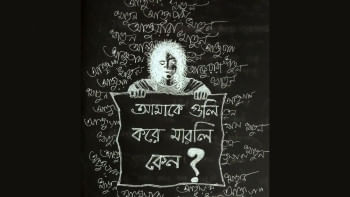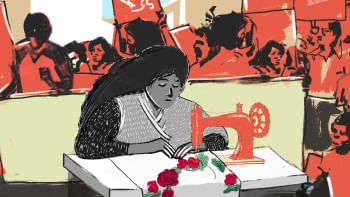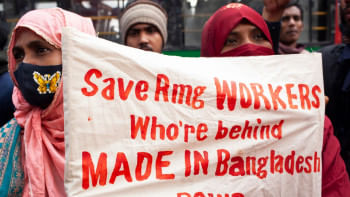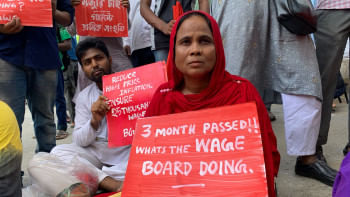Why should RMG workers toil to live below the poverty line?

The Citizen Charter of the Minimum Wage Board states that the board's vision and mission are to fix minimum wages for the purpose of improving the standard of living of all workers in the private sector. But does it fulfil its mission? The poor minimum wages set for different sectors imply otherwise. The fact that the minimum wage board serves the interests of the factory owners and industrialists has again become evident in the recent fixing of only Tk 12,500 as minimum wage for RMG workers, in compliance with the proposal made by factory owners against the demand of Tk 23,000 to Tk 25,000 by the workers.
Garment factory owners in Bangladesh have long been enjoying favours and benefits from the government. More than 60 percent of lawmakers in parliament are businessmen, a significant number of whom are garment factory owners. As a result of this state-business nexus, all the government functionaries, from the labour ministry to the law enforcement agencies, always prioritise protecting the interests of factory owners. When the workers took to the streets to protest the minimum wage of only Tk 12,500, a large number of police, Rab, and BGB personnel were deployed to suppress them. So far, two garment workers have been killed by law and order forces in the ongoing labour movement demanding liveable wages. Instead of revising the minimum wage as demanded by the workers, the government and the owners are trying to suppress the movement by attacking workers, suing them, arresting them, closing down factories, and threatening a hiring halt.
The fact that the minimum wage board serves the interests of the factory owners and industrialists has again become evident in the recent fixing of only Tk 12,500 as minimum wage for RMG workers, in compliance with the proposal made by factory owners against the demand of Tk 23,000 to Tk 25,000 by the workers.
But how acceptable is this minimum wage of Tk 12,500? As per the official dollar rate, Tk 12,500 is equal to $113. But the informal rate is much higher. If one dollar is considered equal to Tk 120, the minimum wage then stands at $104. In 2018, when the minimum wage was fixed at Tk 8,000, the average dollar rate was Tk 83.87. As a result, in dollar terms, the minimum wage in 2018 was $95. So, in five years, the minimum wage of RMG workers increased by only $9-$18.
Be it $104 or $113, they are much lower than the minimum wage of garment workers in any of the countries competing against Bangladesh in the international market. According to a study by the Centre for Policy Dialogue (CPD), the minimum wage in the RMG sectors of Vietnam, India, Cambodia, and Indonesia are, respectively, $170, $171, $200, and $243. If factory owners from other countries exporting to the same international market can afford to pay $170 to $243 to their workers, why can't our garment owners, who enjoy various discounts and benefits from the government, do the same?
Our RMG workers' minimum wage is also significantly lower than that in some local sectors as well. For example, the minimum wage in sawmills, the shipbreaking industry, and the construction and carpentry sectors are Tk 17900, Tk 16,000, and Tk 16,240, respectively. However, garment factory owners receive more benefits from the government than owners in any other private industry of the country, including tax and VAT rebates, cash incentives, low-interest loans from the Export Development Fund (EDF), and duty-free import of raw materials.
According to a report published in Prothom Alo, while other industries have to pay corporate taxes ranging from 20 to 45 percent, the tax rate for garment factories is 10 to 12 percent. In the 2020-21 fiscal year, a total of Tk 3,483 crore tax rebate was given to the RMG, textiles and related sectors. In FY 2019-20, Tk 1,51,738 crore of duty tax exemption was given under the bond facility, of which about 80 percent was given to the RMG sector.
Currently, garment exporters receive a five percent cash incentive when exporting apparel items made from locally procured raw materials, an additional four percent cash incentive for exporting to non-traditional markets, and another one percent cash incentive for exporting to all countries. According to an OECD and United Nations report, for FY 2022-23, the total estimated cost of export cash incentives in Bangladesh amounted to Tk 7,550 crore, of which 65 percent was for the garments and textiles industry.
Despite receiving so many concessions and benefits from the government for years, RMG factory owners are not giving their employees the fair share, due to which the workers have to suffer dearly. A recent survey conducted by the Asia Floor Wage Alliance (AFWA) revealed that workers in our garment sector are consuming just 1,950 kcal in food using Tk 120 per day. But the calorie requirement for a healthy worker living above the poverty line is at least 2,200 kcal. With the recently announced minimum wage of Tk 12,500, it will not be possible for RMG workers to rise above the poverty line because, according to calculations by economist Anu Muhammad, to get 2,200 kcal per person at the market price during September, a family of four would have had to spend at least Tk 23,000 on food alone that month.
Garment factory owners often cite low labour productivity as an excuse for the low wages they offer to workers. But the productivity of labour relies on technology, working environment, management, training, wages, nutrition, and leisure—all of which must be ensured by the employer. According to the Global Alliance for Improved Nutrition (GAIN), 43 percent of female workers in the RMG sector are suffering from malnutrition. If these workers get adequate nourishment, their productivity would rise by 20 percent. According to a survey by the CPD, only two percent of the firms in the garments industry spend on research and development, and their expenditure per worker is only Tk 206, which is alarmingly low considering the size and prominence of the sector. In contrast, the R&D expenditure per worker in the pharmaceutical, tobacco, and paper industries is Tk 23,745, Tk 1,858 and Tk 1,627, respectively. If there is low productivity in the RMG sector, factory owners have only themselves to blame. By not paying workers the wages necessary to afford a decent life, depriving them of rest/leisure, forcing them to work more overtime hours, and not investing enough in workers' training and research, factory owners themselves are causing low labour productivity. Workers should not suffer day after day, toiling under the poverty line, to serve the endless greed and shortsightedness of Bangladesh RMG factory owners.
Kallol Mustafa is an engineer and writer who focuses on power, energy, environment and development economics.
Views expressed in this article are the author's own.
Follow The Daily Star Opinion on Facebook for the latest opinions, commentaries and analyses by experts and professionals. To contribute your article or letter to The Daily Star Opinion, see our guidelines for submission.


 For all latest news, follow The Daily Star's Google News channel.
For all latest news, follow The Daily Star's Google News channel. 











Comments